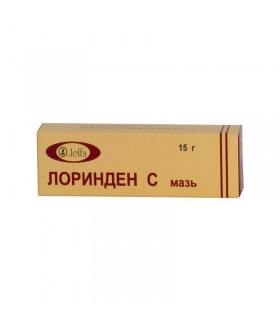




Security policy (edit with Customer reassurance module)

Delivery policy (edit with Customer reassurance module)

Return policy (edit with Customer reassurance module)
Allergomatosis, complicated by the addition of a bacterial infection caused by microorganisms sensitive to clioquinol:
Bacterial and fungal infections of the skin, complicated by the development of local allergic reactions:
Outwardly. The ointment is applied with a thin layer on the skin in the affected area. At the beginning of therapy, the drug should not be used more often 2-3 times a day.; with the appearance of positive dynamics 1-2
The drug should not be used for more than 2 weeks.
If necessary, use with a bandage should use a bandage that allows air to pass through. In case of excessive lichenisation and hyperkeratosis, the ointment is used only under an occlusive dressing 1 time in 24-48 hours. In this case, the duration of use of the drug is not more than 1 week.
It is not recommended to use per day more than 2 g of ointment.
In children and adolescents over 10 years old, the drug can be used only in exceptional cases on limited areas of the skin and avoid applying ointment to the skin of the face.
Local reactions: rarely - burning, itching, steroid acne, stretch marks, dry skin, folliculitis; with prolonged use - atrophy of the skin, local hirsutism, telangiectasia, purpura, pigmentation disorders.
Systemic reactions: with prolonged use and / or application to large areas of the skin, side effects characteristic of GCS are possible.
The use of the drug is contraindicated in the first trimester of pregnancy.
Controlled studies of possible teratogenic effects in the local application of flumethasone and jodhloroksihininina during pregnancy was not carried out, so the drug can be prescribed only when the intended benefit to the mother exceeds the possible risk to the fetus.
It is not known to what extent flumethasone and clioquinol excreted in breast milk when applied externally. Special care should be taken when prescribing the drug during lactation (breastfeeding).Application is possible only in exceptional cases, briefly and in limited areas of the skin (can not be applied on the skin of the mammary glands).
It is not recommended to apply the drug on the skin of the face, you should avoid getting ointment in the eyes.
It is not recommended to increase the duration of the course of treatment or apply for a long time over large areas of skin. With prolonged use of the drug on a large surface area of the skin increases the risk of systemic side effects of corticosteroids.
If a secondary infection occurs at the site of application of the ointment, you should use products with a more pronounced antibacterial or antifungal effect.
With caution should use the drug for atrophic skin changes, especially in the elderly.
With prolonged use may develop resistance microflora to clioquinol.
For fungal diseases with secondary allergic reactions, Lorinden S is used in exceptional cases, under medical supervision.
Influence on ability to drive motor transport and control mechanisms
The drug does not limit the psychophysical activity, the ability to control vehicles and maintenance of moving mechanisms.
Cases of overdose are rare.
Symptoms: with improper, frequent or long-term use in large quantities over large areas, systemic side effects of GCS may occur.
Treatment: gradual withdrawal of the drug; symptomatic therapy.
During therapy with Lorinden C, vaccination and immunization should not be given due to the immunosuppressive effect of the drug.
The drug should not be prescribed in combination with other drugs for external use.
When the drug is absorbed into the systemic circulation, flumetasone reduces the effectiveness of insulin, oral hypoglycemic agents, antihypertensive drugs, anticoagulants, reduces the concentration of salicylates and praziquantel in the serum.
With combined use increases the risk of side effects of androgens, estrogens, oral contraceptives, anabolic steroids (hirsutism, acne); antipsychotic drugs, bucarban, azathioprine (cataract); holinoblokatorov, antihistamine drugs, tricyclic antidepressants, nitrates (glaucoma); diuretics (hypokalemia), cardiac glycosides (digitalis intoxication).
Pharmacy sales terms
The drug is available on prescription.
List B. The drug should be kept out of the reach of children at a temperature not exceeding 25 ° C. Shelf life - 3 years.
Lorinden